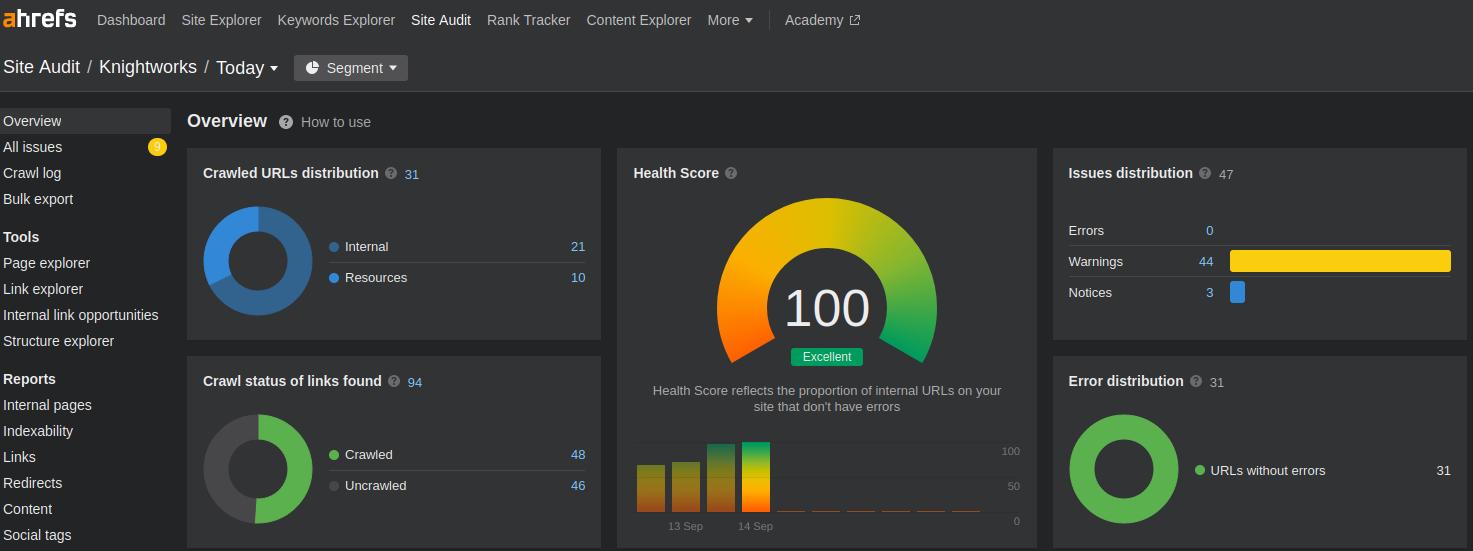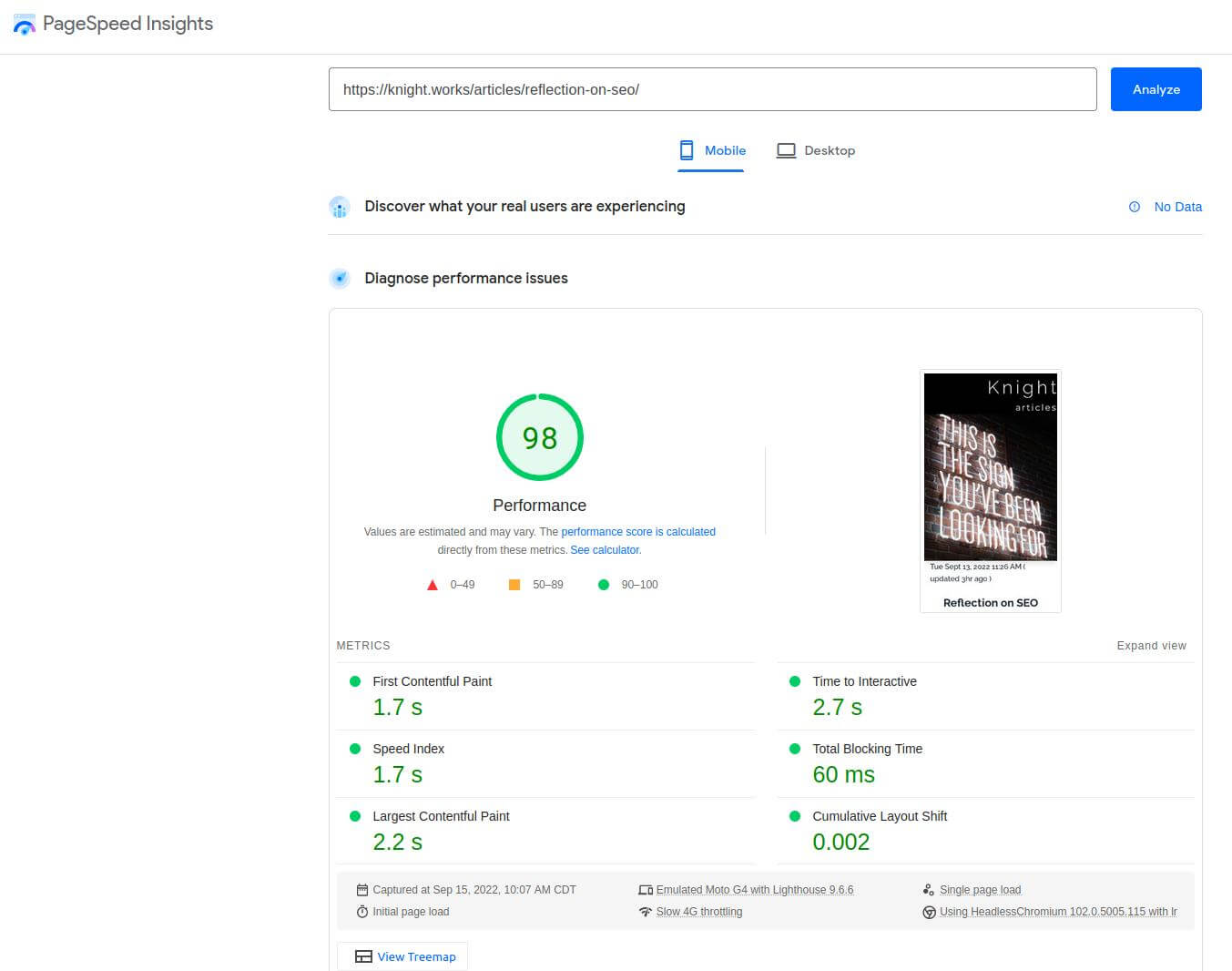
Tue Sept 13, 2022 11:26 AM ( updated 3hr ago )
Reflection on SEO
Objectives
- Explain what SEO is quickly and simply
- Give you an SEO strategy that works
- Give concrete actionable steps along the way
- List the best resources moving forward
📌️ At some point, I will turn this reflection article into a full blown guide.
SEO: What is it?
SEO stands for Search Engine Optimization.
My paraphrase is:
Crafting your content so that the people searching for it, actually find it.
And to be honest, it kinda sounded hard and mysterious to me - until someone came along and said: It’s easy.⁕
And somehow, that had a surprisingly powerful effect for me and hopefully, I can have the same for you.
SEO is simple. BUT, you do need to know the steps to take (like most things in life).
SEO: Some Key Terms
You can breeze through these and reference them later as needed.
- Search Engine: The beast behind the search bar that determines who is found and who is not.
(If you found me, it must have been sleeping at the gate...) - Search Keywords: Kinda what users type into the search bars and what search engines like Google use to find content.
- Search Intent: What the user really wants to find when they search.
- Domain Authority: The importance factor given to your site based on how good your content is and how many other respected sites link back to your site.
- Page Authority: The importance factor given to a web page based on how good your content is and how many other respected sites link back to your page.
- Backlink: A link to your site on another website.
- On-page factors: The factors of your webpage (content & structure) that matter for SEO
- Off-page factors: The factors everywhere else on the internet, besides your webpage, that matter for SEO.
- Analytics: The data (e.g. bounce rate, page views, time on site, etc.) that you use to evaluate the effectiveness of your SEO efforts.
SEO: An Analogy
The best analogy I have heard ⁕ is the one closest to the reality of what websites are: books in a library.
The search engine (e.g. Google) is the librarian and your site / content is a book in one amongst many shelves of books.
Your domain name is “the author” of that content.
The user / customer tells the librarian what he or she wants in as few words as possible (e.g. “SEO Best Practices”), and the librarian then goes and gets the best 10 books (i.e. web pages) on the requested topic.
But what 10 books, you ask?
Broadly speaking, the librarian ranks that list with just 2 things:
- The quality of the content in the book (i.e. your site)
- And all the other references / citations to that book (i.e. your site) everywhere else in the library.
So, imagine every book ever written on “SEO Best Practices” always cites your book for the definitive definition of what SEO is, then your book is probably authoritative and you, most likely, are an expert in that field.
Hence, the librarian knows that your book is a must-have for anyone searching for “SEO Best Practices”, and includes you in the list given back to the requester.
Hopefully, you now understand the concept and logic behind SEO, let’s focus on execution.
The Guide / Strategy for SEO
Step 0: Define Yourself
This step is not really an SEO step but cannot be ignored. It should be an organic step that happens before the first real step of SEO.
Defining your project is the springboard and guiding light in the strategies ahead.
What you write up for yourself here will become the reference point when you get stuck moving forward.
❔ Here is a list of questions to ask
- What is your mission, goal or purpose? Why are you doing this?
- What niche or specific angle that you provide in your area of expertise? (think of your tagline)
- Who is your target audience? (Can you narrow it even more?)
- What is your company name, site name, or domain name?
🛟 Help Finding My Niche
If you're stuck at this stage or just trying to explore options, click here.
Question: What words describe you and your interests?
Answer: FOSS, Privacy, Web Developer, Solopreneur, Javascript, Writer
Take those words and start working out from there:
- What do you have the most expertise in?
- What communities are you in that relate?
- What problems are there related to these topics?
Next Steps
This will help concretize what might be floating around in your head. It doesn’t have to be unchangeable, but it does need to be clear.
If you have yourself defined and a good working vision to start with, then press forward to the SEO steps.
Step 1: Establish Your Site
This step is more of a technical/literal establishment of your existence on the web.
You will need to build up Domain Authority and you can’t do that without…a domain! The most important thing for this SEO step is: the ability to get metrics and the ability to review your site’s performance.
🌐 Buy a domain name (if you haven’t already)
I am going to recommend Cloudflare here. They don’t mark up domain prices to take a cut, which is cool. Check’em out: https://www.cloudflare.com/products/registrar.
Also a lot of our other architecture is built on their platform, so it makes them solid choice.
🕸️ Set up a website
There are a lot of ways you could do this so we won’t go into here, but if you have questions reach out.
📈 Set up website analytics
We currently use Plausible. Plausible is an open source, privacy-focused alternative to Google Analytics. It rocks so far.
#todo should probably make a guide for setting this up
🔎 Get and run a website audit tool
From a technical perspective, you want a tool to review or scan your site for performance and best practices for web standards.
For a site audit on best practices, you can use a free (but limited) version of ahrefs:
Here is an example report for this site:

You’ll need to verify ownership of your site to run the audit.
There is a lot you can review in the sidebar, but focus on the Health Score in the middle (not too shabby).
For performance, you can still use the ahrefs account for site audits, but some simple tools are:
The performance score you really want to pay attention to is for mobile. Desktop scores matter less.

Alright! 🎉, now we have a site up and running, and we can monitor via Plausible. Let’s really begin the journey of building a brand, marketing, community building…whatever you want to call it…because that’s really what this is all about.
Step 2: Go Forth, Be Present, and Establish Authority
If you’re like me, then this is a step you’d rather not take. But we have to. It separates the wheat from the tare, those who want to begin from those who get somewhere.
Notice the natural increase in effort and commitment you’ll have to give across these next 3 actions.
🔗 Make some connections
You need to start making relationships with others.
- Find where your diehard fans are.
- Find where other leaders in this space are.
- Find quality sites that focus on your topic.
👏 Comment and contribute
Once you have some connections and are in some communities, start making contributions. BE HELPFUL.
What’s great here is that you can start small. Nothing has to be a masterpiece.
✍️ Write guest posts
As you research and get to know others, write a Guest Post for their site. The key thing you want (besides being helpful) is the backlink to your site.
What are the sites with highest
domain authoritythat you could get on?How do you write with SEO in mind?
Writing for SEO is a big topic and has its own page. Work in process
As you do this on reputable sites, you’ll slowly but surely build up your Domain Authority.
🌟The Goal🌟: Get your Domain Authority up to 30.
You can view your rating using the ahrefs tools mentioned above or here.
Once your Domain Authority gets around 30, you can start looking to partner with others to also write on your site.
But more importantly it’s time to write content for your site.
Step 3: Build Your Castle
This step looks short but is very important.
📄 On-page Factors
Here, we really care about those on-page factors. Proper execution in your page title, your headers, the body text, and page schemas.
This step is all about writing great content and “optimizing” that content.
Once you’ve written your article using the info above, move on to step 4.
Step 4: Send Your Content Out
Once you have a piece of content, send it out to all your networks, channels, and communities!
It can also help to update your own pages that get some traffic with links if it works.
Get feedback as much as you can.
🚀 If you are launching an app
Here is a list of sites you can post to: Beta Launch Sites for Apps
Step 5: Evaluate and Adapt
Throughout the process we evaluate how the site and content are doing. This is where all that stuff setup at the beginning comes into play.
The tools we can use are:
- Google Search Console
- ahrefs (from above)
👀 The 1st thing to look at
The first thing to focus on when you are starting out is: are you ranking for the keywords you want to be ranking for? Are you moving up the ranking? This is the good first metric to use for success because the other numbers like click through and bounce rate haven’t happened yet.
👀 Other stuff to look at once you get traction (i.e. clicks)
- Organic Traffic (keywords)
- Bounce Rates
- Time On Site
- Page Views
- High Traffic Pages
- Backlinks
How to do this is better suited for the guide and depends on the tool you use, and the niche you are in.
Wrapping Up
- Get a site going with some audit tools
- Get backlinks by posting on other sites until Domain Authority is about 30
- Write content on your site
- Share that content out
- If the content is good, then SEO traffic will start to follow
SEO is a long term game. Good luck.
Resources
Tools
This list is far from complete, I will need to update later.
Google Trends
SEO Tool Database
References
- Ahref: https://www.youtube.com/watch?v=xsVTqzratPs
- buildd: https://www.youtube.com/watch?v=sBfgK56obcM&list=PL26HDuZxjHKvXwYjsmx8s3UTTtwMftAuj&index=2
- https://backlinko.com/google-ranking-factors
- https://backlinko.com/seo-checklist#basics
⁕Buildd
Check out the SEO for Startups course by Karthik and team for a true walk-through on the SEO Process. I owe a lot of my understanding above to them. It’s an awesome course. -> To the course